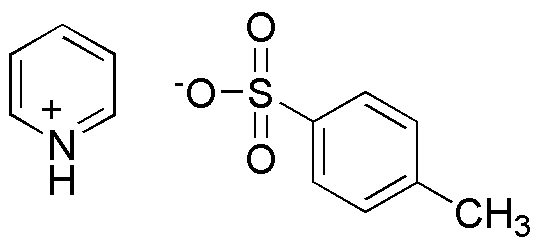Pyridinium p-toluenesulfonate is widely utilized in research focused on:
- Organic Synthesis: This compound serves as an effective catalyst in various organic reactions, enhancing reaction rates and yields, particularly in the synthesis of complex organic molecules.
- Pharmaceutical Development: It is used in the formulation of drugs, where it acts as a stabilizing agent, improving the solubility and bioavailability of active pharmaceutical ingredients.
- Analytical Chemistry: Pyridinium p-toluenesulfonate is employed as a reagent in analytical methods, such as chromatography, aiding in the separation and identification of compounds in complex mixtures.
- Polymer Chemistry: This chemical is utilized in the production of specialty polymers, where it contributes to the modification of polymer properties, enhancing their performance in various applications.
- Environmental Applications: It finds use in environmental chemistry for the treatment of wastewater, helping to remove pollutants through its catalytic properties.
General Information
Properties
Safety and Regulations
Applications
Pyridinium p-toluenesulfonate is widely utilized in research focused on:
- Organic Synthesis: This compound serves as an effective catalyst in various organic reactions, enhancing reaction rates and yields, particularly in the synthesis of complex organic molecules.
- Pharmaceutical Development: It is used in the formulation of drugs, where it acts as a stabilizing agent, improving the solubility and bioavailability of active pharmaceutical ingredients.
- Analytical Chemistry: Pyridinium p-toluenesulfonate is employed as a reagent in analytical methods, such as chromatography, aiding in the separation and identification of compounds in complex mixtures.
- Polymer Chemistry: This chemical is utilized in the production of specialty polymers, where it contributes to the modification of polymer properties, enhancing their performance in various applications.
- Environmental Applications: It finds use in environmental chemistry for the treatment of wastewater, helping to remove pollutants through its catalytic properties.
Documents
Safety Data Sheets (SDS)
The SDS provides comprehensive safety information on handling, storage, and disposal of the product.
Product Specification (PS)
The PS provides a comprehensive breakdown of the product’s properties, including chemical composition, physical state, purity, and storage requirements. It also details acceptable quality ranges and the product's intended applications.
Certificates of Analysis (COA)
Search for Certificates of Analysis (COA) by entering the products Lot Number. Lot and Batch Numbers can be found on a product’s label following the words ‘Lot’ or ‘Batch’.
*Catalog Number
*Lot Number
Certificates Of Origin (COO)
This COO confirms the country where the product was manufactured, and also details the materials and components used in it and whether it is derived from natural, synthetic, or other specific sources. This certificate may be required for customs, trade, and regulatory compliance.
*Catalog Number
*Lot Number
Safety Data Sheets (SDS)
The SDS provides comprehensive safety information on handling, storage, and disposal of the product.
DownloadProduct Specification (PS)
The PS provides a comprehensive breakdown of the product’s properties, including chemical composition, physical state, purity, and storage requirements. It also details acceptable quality ranges and the product's intended applications.
DownloadCertificates of Analysis (COA)
Search for Certificates of Analysis (COA) by entering the products Lot Number. Lot and Batch Numbers can be found on a product’s label following the words ‘Lot’ or ‘Batch’.
*Catalog Number
*Lot Number
Certificates Of Origin (COO)
This COO confirms the country where the product was manufactured, and also details the materials and components used in it and whether it is derived from natural, synthetic, or other specific sources. This certificate may be required for customs, trade, and regulatory compliance.


